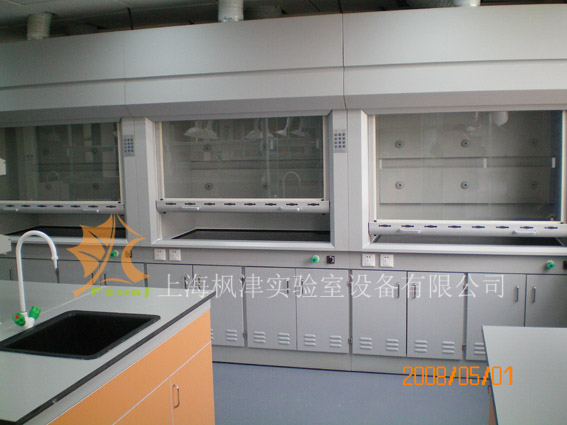
Laboratory fume hoods are an integral part of the laboratory design. In order to prevent laboratory workers from inhaling or ingesting some toxic, pathogenic or toxic chemicals and organisms, there should be good ventilation in the laboratory. To prevent the absorption of some vapors, gases and particulates (smoke, soot, dust and aerosols), the pollutants must be removed by means of a fume hood, hood or partial ventilation. The structure of the fume hood is of the upper and lower type, and has a vent hole at the top to install a fan.
There are baffles in the upper cabinet, the circuit controls the touch switch, the power socket, etc. The see-through window is made of tempered glass, which can be moved left and right or up and down. For human operation.
The lower cabinet adopts the experimental side table style with a countertop on top and a cabinet on the bottom. Small cups and faucets can be installed on the countertop.
The material of the fume hood is various, all steel, steel wood, all wood, aluminum wood, plastic steel, PVC structure, etc. The table top is directly in contact with the operator, from solid core physics and chemistry board, stainless steel plate, PVC, ceramic And other materials.
Old fume hoods are mostly made of wood, but modern ones are mostly made of epoxy-coated steel. Common cabinet widths are 1000, 1200, 1500, 1800 and 2000 mm, 700-900 mm deep and 1900-2400 mm high. It can be used by 1-3 people at the same time. The fume hood is typically mounted against a wall.
In the middle of the front is a transparent door (mostly glass) that can move up and down, and the opening height is generally 100-600 mm. After the door is the experimental work surface, there are connections required for experiments such as water pipes, sewers, power supplies, vacuum pumps, gas lines, etc., and there is a lamp with a protective cover. The air is taken away by the exhaust fan in the front upper part of the cabinet, or led to another place (called full ventilation), or recirculated through filtration (becoming ductless ventilation).
Most fume hoods alert the operator when (1) the exhaust volume is too small (2) the front glass door is too large to open. The internal exhaust fan speed and lamp are both adjustable.
When using it, stand or sit in front of the cabinet, lower the glass door as much as possible, and push the hand through the door into the cabinet for experiment. Since the exhaust fan draws inward through the open door, the harmful gas does not overflow in a large amount under normal conditions.
1. Upper cabinet part:
There are three styles: standard, low table, floor type.
Whether the surface wind speed of the fume hood meets the safety wind speed requirements specified by international standards: 0.5m/s (international standard stipulates: only the surface wind speed can reach 0.5m/s to effectively capture the harmful gas in the cabinet).
The opening height of the fume hood is suitable for your operating space.
Ventilation control system: constant air volume, variable air volume or adaptive control system.
Lining material: PP, fiberglass or polyethylene resin.
Whether the material of the door is adjusted with safety glued glass is designed to conform to the human body mechanics, so that the operator can pull freely.
2. Countertop part:
Whether the countertop uses a safe dish design makes it easy for users to clean the countertop and prevent leakage of toxic liquids.
Whether the material of the countertop meets the requirements of your experiment and resists the corresponding erosion and high temperature.
Is there a cup slot or sink installed and the location is reasonable?
Whether the design of the air outlet is reasonable.
3. Base cabinet part:
Whether the material is strong and durable, whether it is fireproof material, whether it can resist the erosion of the laboratory acid and alkali environment.
Whether the power supply is reasonable and safe.
Is it easy to repair water, electricity and gas systems?
Whether the base cabinet needs a pumping design so that you can place volatile drugs.
Once you have basically selected the model, style and size of the fume hood, you can determine what you need based on the following conditions.
4. Accessories:
Water source: distilled water, pure water or reverse osmosis water.
Source of gas: nitrogen, oxygen or air.
The choice of electrical system should be considered: model, voltage, riot, durability and so on.
For aesthetic reasons, it is necessary to seal the board.
Three Wheel Aluminum Rollator
Help to Stand up:This Three Wheel Aluminum Rollator provides effective support to help you stand up. It will greatly speed up the recovery process of patients with leg and foot injuries.
Rollator with Shopping bag,The rolling walker includes a large storage bag with pockets for ID cards and cell phone. Transport yourself and your accessories with ease as you cruise through your day. It folds neatly and is a great choice for the elderly or handicap.
The three wheel rollator features one wheel in the front and two wheels in the back. This adult walker is perfect for senior members of the family who still want their independence.
Contains (1) Rolling Walker, Deluxe Three Wheel Aluminum Rollator. Lightweight, foldable & compact for easy maneuverability in tight spaces. Collapses quickly for storage & transport. Large storage bag & height adjustable handles. wheels with locking brakes, one of the leading walkers in the category.
With height adjustable handles, the Rolling Walker is easy to customize for an ideal comfort level. The wheels with locking brakes mean you get the support you need whether standing still or rolling smoothly along. Quick tool-free assembly
Deluxe Three Wheel Aluminum Rollator ,3 Wheel Rollator,New design Tri walker,Rollator with Shopping bag
Foshan Oscar Medical Instrument CO.,LTD , https://www.fsoscarmed.com
